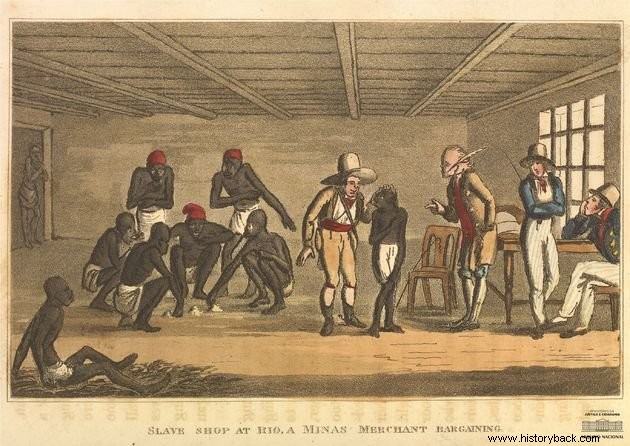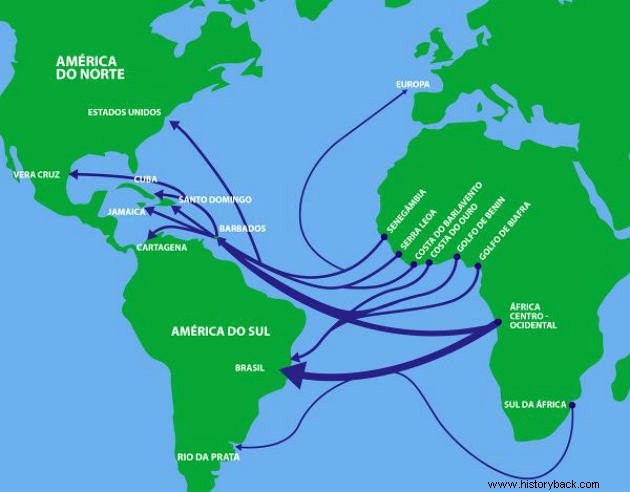The slave trade represents the phase when black Africans were brought from Africa to be slaves.
The trade of black Africans as slaves was one of the main commercial activities of the dominant countries in the period from 1501 to 1867.
Africa-America Trade
The practice was managed by six nations:England, Portugal, France, Spain, the Netherlands and Denmark.
The commercial justification for supporting the exploitation of African slaves was that only with slaves would it be possible to maintain low prices for products such as sugar, rice, coffee, indigo, tobacco, metals and precious stones.

The slave trade was responsible for the forced displacement of 12.5 million people from Africa and an estimated one third went to Portuguese America. This was the largest involuntary displacement of people in all of history.
Of the total, 12.5% were unable to complete the crossing because they were still dying on the ships due to poor hygiene conditions that allowed the spread of diseases or the punishments applied to curb revolts.
This commercial practice of slavery constituted the most important objective of interaction between Europeans and Africans, previously separated by the power of the sea.
The discovery of the New World made it possible to expand the production of several products required by Europe, however, the available labor was insufficient.
The indigenous populations found in the new territory, while remaining captive, collapsed as a result of physical extermination and disease in certain territories.
On the other hand, free immigrants or even prisoners sent forcibly to America were never enough to meet the needs of production.
It was the forced and unpaid labor of the African that guaranteed the European consumer access to precious metals, sugar, coffee and others produced in the colonies.
See also:ColonialismAfrican Slaves
The explanation for the use of forced African labor in the colonies is the subject of several streams of historical research.
In the beginning it was justified that blacks were inferior, that they had lost a war and thus could be enslaved.
There was also the belief that the African black was enslaved because the Indian did not allow himself to be enslaved or because he died of diseases brought by the colonizers.
Slavery was an institution present in African societies, but it had no commercial purposes, and represented domination and power of the stronger over the weak.
In the midst of African societies, European rule was also favored by Africans who sold slaves to colonizers.
Enemies were the only "merchandise" they had to offer and thus, to be able to buy the valuable objects brought by the Europeans.
In possession of vigorous nautical technology, Europeans were forcibly transporting Africans to the other continent and denying them the right to their own lives. These were given to future owners on the sugar and coffee farms.
See also:Slave ShipsRoutes
Captive slaves were transported by various routes out of Africa. Even before large-scale commercial exploration began, there were routes to Europe via the islands of the Atlantic and Mediterranean Sea.
These would have been the first to forcibly leave for America to work on the sugar plantations.

The sugar sector absorbed 80% of the blacks taken from Africa. There were two points, the north, for expeditions from Europe and North America; and the south, departing from Brazil.
The ports that received the most blacks were located in Rio de Janeiro, Salvador (BA) and Recife; in England Liverpool, London and Bristol stand out. In France, the city of Nantes was an important selling point for enslaved people. Together, these ports were responsible for receiving 71% of the slaves.
The main starting points in Africa were located in Senegambia, Sierra Leone, the Windward Coast, the Gold Coast, the Gulf of Benin and, most importantly, West-Central Africa.
Indian Ocean
The Atlantic trade was not the only African slave trade. As early as the 1st century AD were brought as slaves through the Sahara desert, coming from the east African coast.
These captives were destined for slavery in North Africa, in the Middle East, for which they continued their journey across the Indian Ocean.
Most of this trade was in the hands of Muslim merchants who supplied Muslim kingdoms with slaves for domestic services and concubinage.
Prohibition
The prohibition of the slave trade began in Europe itself after the beginning of an ideological battle. There are historians, however, who point to the high prices of slave labor as a justification for the end of exploitation in a period of increasing industrialization.
Debates for ending the slave trade began in England, even with the auspicious profits of the practice. In 1807, the traffic in blacks was considered illegal by the British and, in the same year, by the US government.
The government of England started to directly restrain the traffic from 1810, using 10% of the maritime fleet in the interception of slave ships.
In turn, the Brazilian government only acted later in 1850, with the Eusébio de Queirós Law, but only in 1888 did it abolish slavery.
See also:End the African Slave TradeBrazil
Brazil was responsible for 40% of the black trade for the exploitation of slave labor. Of the approximately 12.5 million people exploited, 5.8 million landed in the country, according to some studies.
Trade in the colonial era began in 1560 as a way of securing workers in the monoculture of sugar. Demand was high and by 1630, Brazil was the main supplier of sugar to Europe.
See also:Slavery in BrazilRead more :
- Colonial Brazil
- Indigenous Slavery in Colonial Brazil
- Abolition of Slavery in Brazil
- African Culture
- Spanish Colonization
